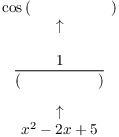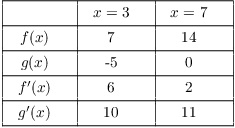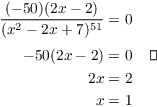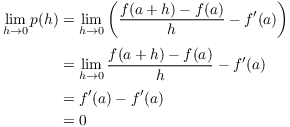The Chain Rule computes the derivative of the
composite of two functions. The composite ![]() is just "g inside
f" --- that is,
is just "g inside
f" --- that is,
![]()
(Note that this is not multiplication!)
Here are some examples:
![]()

![]()

![]()

Here's a more complicated example:
![]()

One way to tell which function is "inside" and which is
"outside" is to think about how you would plug numbers in.
For example, take ![]() . What would you do to
compute
. What would you do to
compute ![]() on your calculator? First, you'd square 1.7 ---
on your calculator? First, you'd square 1.7 --- ![]() . Next, you'd take the sine of that ---
. Next, you'd take the sine of that --- ![]() .
.
The function you did first --- squaring --- is the inner function. The function you did second --- sine --- is the outer function.
Example. Suppose
![]()
Compute ![]() ,
, ![]() , and
, and ![]() .
.
![]()


Theorem. ( Chain Rule)
If f is differentiable at a and g is differentiable at ![]() , then the composite function
, then the composite function ![]() is differentiable at a, and its derivative
is
is differentiable at a, and its derivative
is
![]()
In functional form, this is
![]()
In words, you differentiate the outer function while holding the inner function fixed, then you differentiate the inner function.
The proof is pretty technical, and you can omit it if you're taking a typical first-term calculus course. It is given at the end. In the examples, I'll focus on how you use the Chain Rule to compute derivatives.
Example. Compute ![]() .
.
![]() looks like this:
looks like this:

Differentiate the outer function ![]() ,
obtaining
,
obtaining ![]() . What is "junk"? It's
. What is "junk"? It's
![]() . The first term in the Chain Rule is
. The first term in the Chain Rule is ![]() . (Notice that I differentiated the outer
function, temporarily leaving the inner one untouched.)
. (Notice that I differentiated the outer
function, temporarily leaving the inner one untouched.)
Next, differentiate the inner function. The derivative of ![]() is
is ![]() .
.
Therefore,
![]()
Example. Compute ![]() .
.
While it would be correct to use the Quotient Rule, it's unnecessary.

That is,
![]()
In general, you do not need to use the Quotient Rule to differentiate things of the form
![]()
In the first case, use the Chain Rule as above. In the second case,
divide the top by the number on the bottom.![]()
Example. Compute ![]() .
.
![]()
In some of the examples which follow, I'll use the derivative
formulas for ![]() and
and ![]() . They are:
. They are:
![]()
Example. Compute ![]() .
.

Example. Compute ![]() .
.

Therefore,
![]()
Example. f and g are differentiable functions. A table of some values for these functions is shown below.

Find ![]() .
.
By the Chain Rule,
![]()
Example. Compute ![]() .
.
![]()
Example. (a) Compute ![]() .
.
(b) Draw a picture to show the difference between the functions ![]() and
and ![]() , considered as composites of
, considered as composites of ![]() and
and ![]() .
.
(a)
![]()
(b) Here's a picture showing the difference between ![]() and
and ![]() :
:

In the first case, the outer function is the squaring function; in
the second case, the outer function is the sine function.![]()
Example. The derivative formulas for ![]() and
and ![]() are
are
![]()
Taking these for granted, find:
(a) ![]() .
.
(b) ![]() .
.
(a)
![]()
(b)
![]()
Example. Compute ![]() .
.
Differentiate from the outside in:
![]()
Example. Where does the graph of ![]() have a horizontal tangent?
have a horizontal tangent?
![]()
Set ![]() and solve for x:
and solve for x:

The proof of the Chain Rule.
This section is fairly technical, so you can probably skip it if you're reading this for first-term calculus.
Lemma. If f is differentiable at a, there is a
continuous function ![]() which satisfies:
which satisfies:
(a) ![]() .
.
(b)
![]()
Proof. Define

Then

Thus,
![]()
Hence, p is a continuous function. This proves (a).
Note that for ![]() ,
,

For ![]() , this equation is true, since both sides are 0. This
proves (b).
, this equation is true, since both sides are 0. This
proves (b).![]()
Theorem. ( Chain Rule)
Suppose that ![]() . Assume f is differentiable at a and g is
differentiable at
. Assume f is differentiable at a and g is
differentiable at ![]() . Then the composite
. Then the composite ![]() is differentiable at a, and
is differentiable at a, and
![]()
Proof. By the lemma, there are functions p and q such that
![]()
![]()
![]()
Here ![]() . Thus, as
. Thus, as ![]() , I have
, I have ![]() . By the rule for the limit of a
composite, this means that as
. By the rule for the limit of a
composite, this means that as ![]() , I have
, I have ![]() .
.
The next few steps may be a little hard to follow, so I'll give some detail before I do the computation.
I will take the equation ![]() and substitute as follows:
and substitute as follows:
1. On the left side, I'll plug in ![]() .
.
2. On the right side I'll plug in ![]() in for k.
in for k.
Now here's the computation:

Now take the limit as ![]() on both sides. Remember that as
on both sides. Remember that as
![]() , I have both
, I have both ![]() and
and ![]() .
.
![]()
Copyright 2018 by Bruce Ikenaga